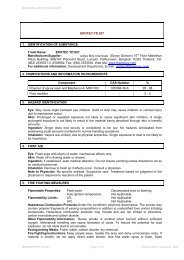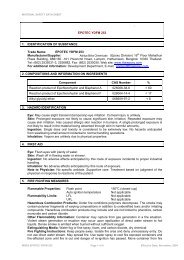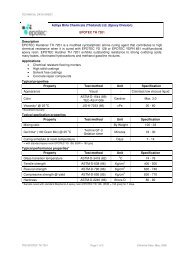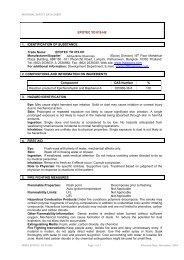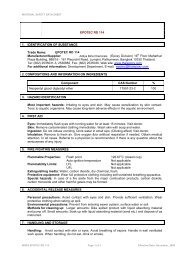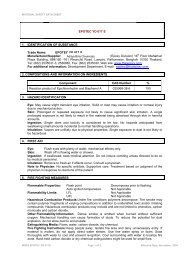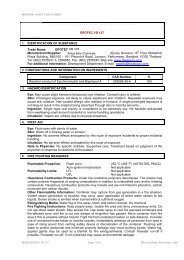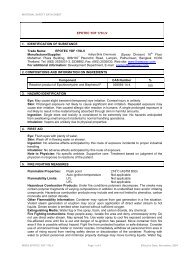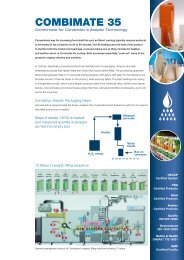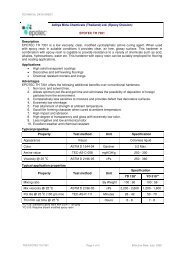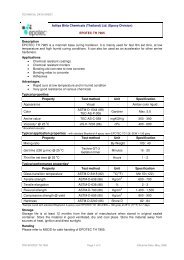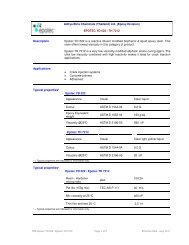Epotec - electrical and electronic applications - Aditya Birla Chemicals
Epotec - electrical and electronic applications - Aditya Birla Chemicals
Epotec - electrical and electronic applications - Aditya Birla Chemicals
Create successful ePaper yourself
Turn your PDF publications into a flip-book with our unique Google optimized e-Paper software.
®<br />
Processes & Applications<br />
<strong>Epotec</strong> ® Epoxy Systems are best known for casting<br />
into molds, cavities, cores <strong>and</strong> patterns. They are<br />
also extensively used for encapsulation<br />
(encapsulation <strong>and</strong> embedment are frequently used<br />
inter-changeably), impregnation <strong>and</strong> protection of<br />
<strong>electrical</strong> <strong>and</strong> <strong>electronic</strong> assemblies <strong>and</strong><br />
components. Usually low-pressure-reacted resins<br />
are utilized <strong>and</strong> curing is performed at room<br />
temperature to elevated temperature, up to 200°C.<br />
Room temperature curing <strong>Epotec</strong> ® Systems are<br />
preferred for low voltage, small components, while<br />
heat-cured <strong>Epotec</strong> ® Systems offer extremely high<br />
physical, thermal <strong>and</strong> chemical resistance. As such,<br />
heat-cured <strong>Epotec</strong> ® Systems are used for medium<br />
<strong>and</strong> high voltage <strong>applications</strong>.<br />
There are few common process techniques for use<br />
of <strong>Epotec</strong> ® Epoxy Resins in <strong>electrical</strong> <strong>and</strong> <strong>electronic</strong><br />
components.<br />
Pottings<br />
Potting is a variation of casting in which the<br />
prefabricated mold, a thin shell of metal or plastic,<br />
becomes an integral part of the finished product.<br />
The resin is fluid enough to flow around the<br />
components being embedded <strong>and</strong> fills all voids,<br />
including the container. Potting is used frequently to<br />
reduce weight, avoid breakdown <strong>and</strong> prevent failure<br />
due to moisture <strong>and</strong> vibration in components.<br />
Encapsulation<br />
Encapsulation is a method of providing a protective<br />
coating on the inside of coils, closed-packed<br />
<strong>electronic</strong> assemblies <strong>and</strong> wire bundles. For<br />
saturation of components it is essential to select<br />
<strong>Epotec</strong> ® Resins of high flow <strong>and</strong> high wetting<br />
properties. The components finally are surrounded<br />
by a thin film of resin. Components encapsulated in<br />
this manner maintain high <strong>electrical</strong> insulation,<br />
excellent environmental protection against heat,<br />
moisture <strong>and</strong> chemicals, <strong>and</strong> also protect<br />
micro<strong>electronic</strong> assemblies with their fine interconnection.<br />
Impregnation<br />
Encapsulation is more of a coating process which<br />
allows minimum penetration of resin into compact<br />
assemblies, whereas impregnation is a process<br />
specifically designed to ensure that the liquid resin<br />
has completely entered into interstices of assembly<br />
prior to curing. Some transformer <strong>and</strong> <strong>electronic</strong><br />
equipment manufacture requires both encapsulation<br />
<strong>and</strong> impregnation.<br />
6<br />
<strong>Epotec</strong> ® Epoxy Systems | Electrical <strong>and</strong> Electronic



